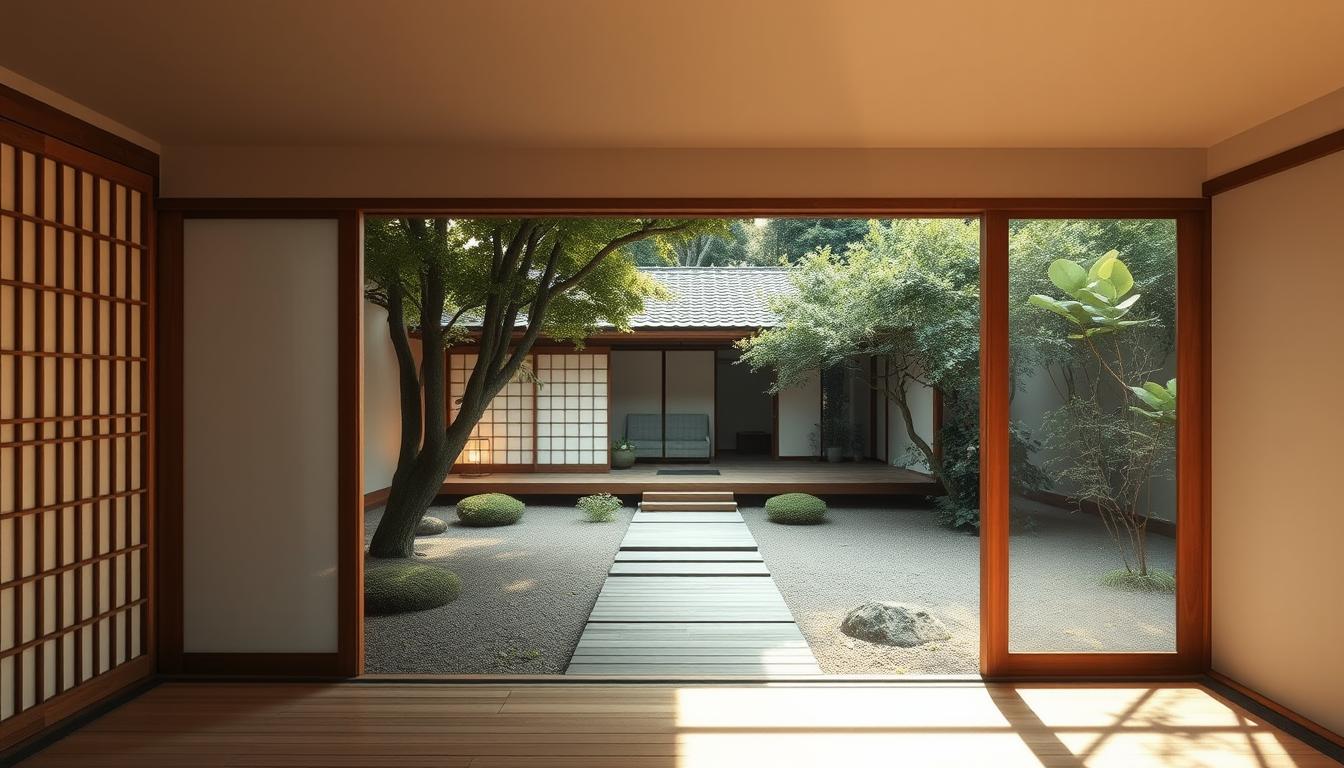More people are turning to peaceful design to create a relaxing home environment. Searches for calming decor have risen by 36% since 2022, showing a growing trend toward simplicity and balance.
This style blends Japanese minimalism with modern comfort. It helps reduce stress and improves focus while keeping spaces functional. Whether refreshing a living room or designing a quiet corner, small changes make a big difference.
Experts like Tirzah Goodman recommend natural materials and soft colors. The best part? You don’t need a full remodel—thoughtful updates with existing furniture work wonders.
Key Takeaways
- Calming design trends are growing in popularity for modern homes.
- Simple updates can transform any space into a peaceful retreat.
- Natural elements and neutral tones enhance relaxation.
- Affordable changes create a big impact without major renovations.
- Versatile ideas fit any room, from bedrooms to reading nooks.
Introduction to Zen House Aesthetic Ideas
Rooted in ancient traditions, Zen-inspired spaces blend simplicity with deep meaning. Originating in Japanese Buddhist temples, this style merges mindfulness practices with intentional design. Natural elements like wood and stone create harmony, while empty space (‘Ma’) offers visual breathing room.
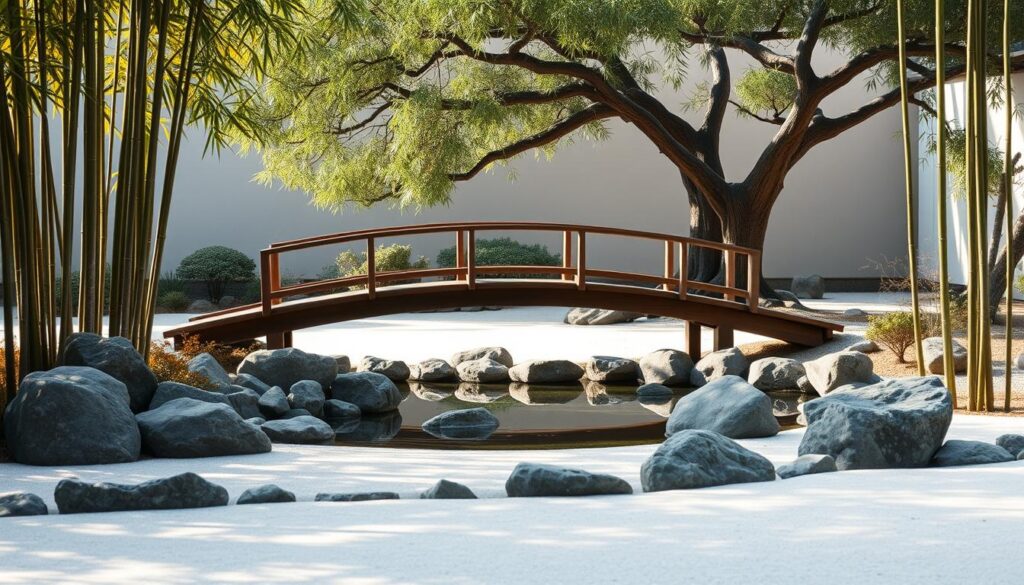
Mayo Clinic research found a 31% reduction in stress levels in rooms following Zen principles.
The design’s focus on order and balance helps calm themind, making it ideal for modern life.
Core principles include minimalism, organic textures, and purposeful layouts. Contrary to myths, these spaces aren’t stark—they’re warm and inviting. A single handmade clay vase or a bamboo shelf can cultivate peace without clutter.
Urban apartments and suburban homes alike benefit. Small tweaks, like sliding Shoji screens or a corner meditation spot, adapt the zen design philosophy. It’s about creating a sanctuary, not perfection.
1. Embrace Earthy Color Palettes
Earthy tones create an instant sense of harmony and warmth. Dulux’s 2023 Color of the Year, “Wild Wonder,” sparked an 18% surge in earthy palette sales, proving their timeless appeal. These hues ground a room while promoting relaxation.
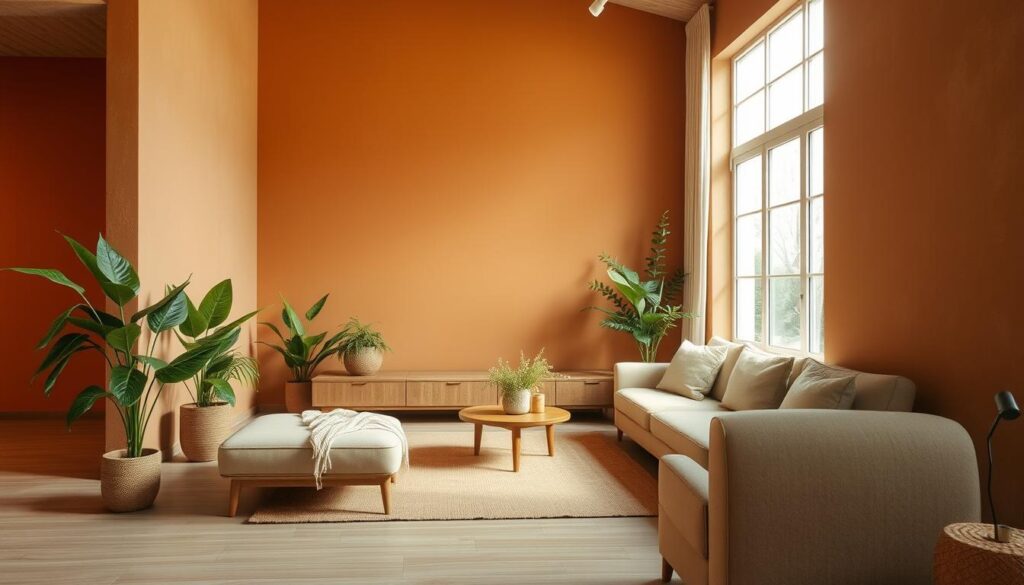
Neutral Foundations
Start with versatile base colors like Benjamin Moore OC-117 Simply White or Sherwin-Williams 7048 Urbane Bronze. Warm neutrals (sandy beige) suit north-facing rooms, while cool greys balance sun-drenched spaces.
Layered Depth
Follow the 60-30-10 rule: 60% dominant (walls), 30% secondary (furniture), 10% accent (decor). Textured finishes—limewash or clay—add tactile interest without clutter.
A Mumbai apartment used Farrow & Ball’s Skimming Stone to unify an open-plan layout, blending living and dining areas seamlessly.
Avoid undertone clashes between floors and walls. Test swatches in natural light to ensure cohesion. The right palette elevates both mood and comfort, turning any space into a retreat.
2. Prioritize Natural Materials
Sustainable materials are reshaping modern interiors with their timeless appeal. Teak wood sales jumped 22% last year, proving their popularity in homes seeking both style and eco-consciousness. These natural materials add warmth while promoting sustainability.
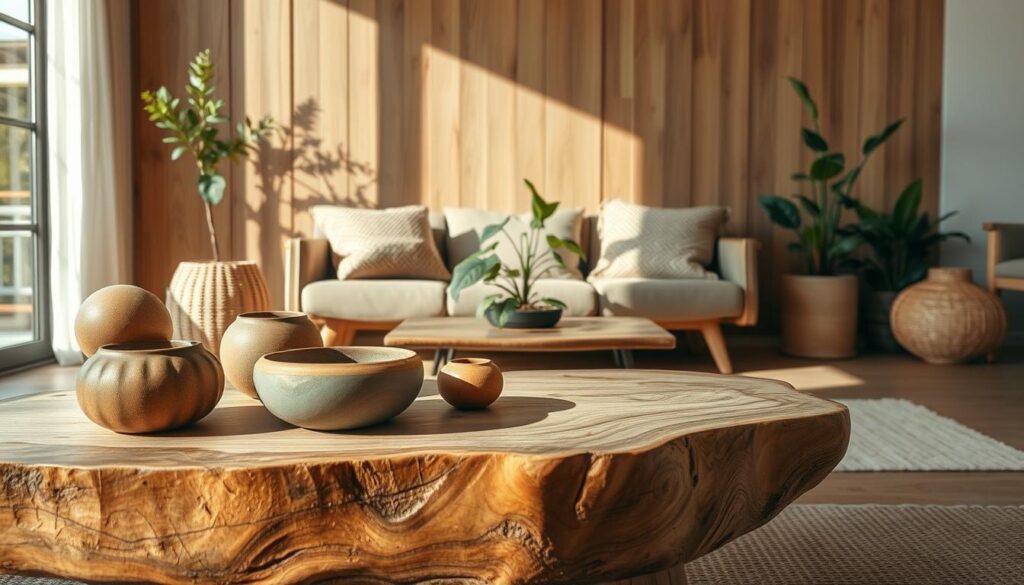
Wood and Bamboo for Furniture
Bamboo stands out for its rapid growth, making it a top eco-choice. Walnut, though slower to mature, offers unmatched durability. Artisans enhance wood with techniques like shou sugi ban, a Japanese charring method that boosts longevity.
For small spaces, repurposed railway sleepers—like those in a Malaysian home—add rustic charm. Prevent warping by keeping bamboo away from humidity.
Stone or Clay Decor Pieces
Basalt water features and marble side tables introduce earthy elements. Pair them with rattan baskets or linen textiles for balance. Seal porous stones like travertine to avoid stains.
A designer in Austin combined jute rugs with ceramic vases, proving even small touches transform rooms.
Clay pots, with their organic imperfections, bring handmade character. These natural materials turn any interior into a grounded retreat.
3. Create a Minimalist Foundation
Minimalism isn’t about empty rooms—it’s about intentional choices that elevate daily life. Marie Kondo’s 2024 report shows a 57% retention rate for spaces designed with simplicity in mind. Start with low-profile furniture that hugs the floor, like Article’s Sven sofa or MUJI’s modular systems.
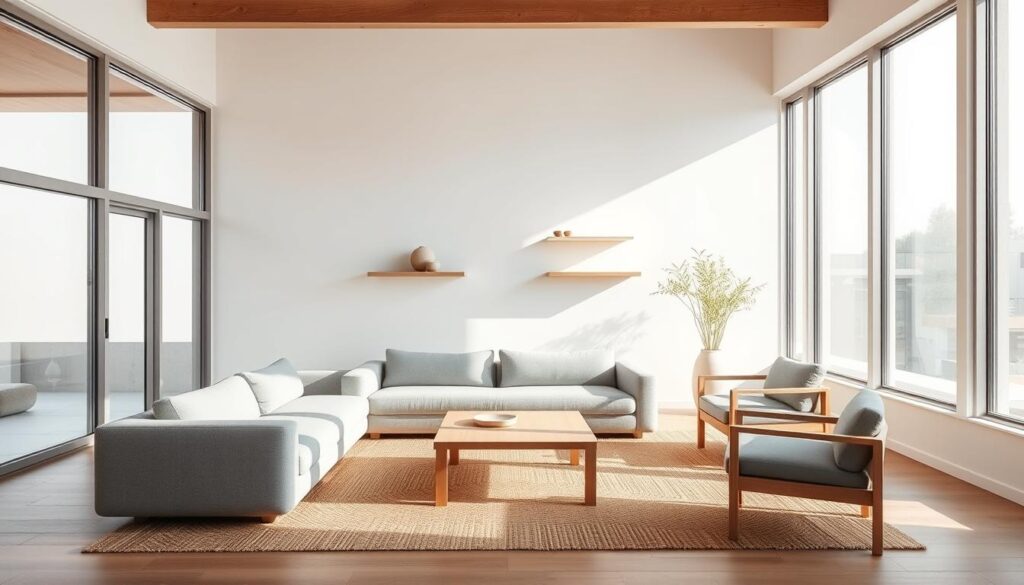
Functional Furniture with Flow
Japanese hikkomori principles arrange pieces to encourage movement. Leave 30 inches between items for easy navigation. Floating shelves and ottomans with hidden compartments maximize storage without visual clutter.
Decluttering in Four Steps
Follow this method to refresh any room:
- Sort: Keep only what sparks joy or serves a purpose.
- Donate: Local charities often pick up gently used items.
- Conceal: Use woven baskets for remotes or magazines.
- Maintain: Dedicate 5 minutes daily to tidying surfaces.
A Gurgaon apartment used built-in window seats with under-seat drawers, doubling seating and storage in 200 sq ft.
Avoid starkness—add warmth with a textured rug or a single statement plant. Minimalism should feel inviting, not austere.
4. Incorporate Soft, Diffused Lighting
The right glow can turn chaos into calm in seconds. Lighting shapes a room’s atmosphere, making it essential for relaxation. Philips Hue reports a 41% surge in smart lighting installations for peaceful spaces.
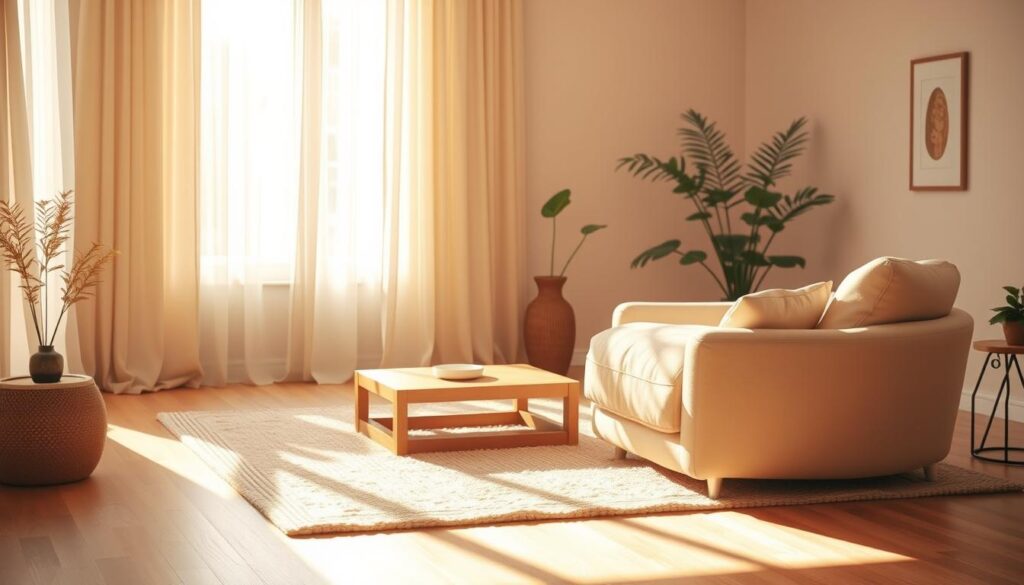
Dimmer Switches and Paper Lanterns
Dimmable LEDs let you adjust brightness for any time of day. Aim for 300–500 lumens in living areas and 200 in bedrooms. Paper lanterns, like those from IKEA, scatter light gently without harsh shadows.
Compare options:
- LED strips: Ideal for under shelves or beds.
- Pendant lamps: Choose frosted glass for softer look.
Scented Candles for Ambiance
Diptyque’s Baies or Jo Malone’s Wood Sage & Sea Salt add fragrance and flicker. For safety, try flameless LED candles. A Johor Bahru home layered both for a cozy yet clutter-free atmosphere.
Circadian rhythm lighting—warm at night, cool by day—boosts sleep quality by 27%.
Pair these tips with boho decor ideas for a holistic retreat. Light isn’t just functional—it’s the soul of a serene space.
5. Designate a Meditation Nook
63% of meditators find dedicated spaces significantly improve their practice. Even a tiny area can become a sanctuary with the right elements. Focus on comfort, personal touches, and adaptability.
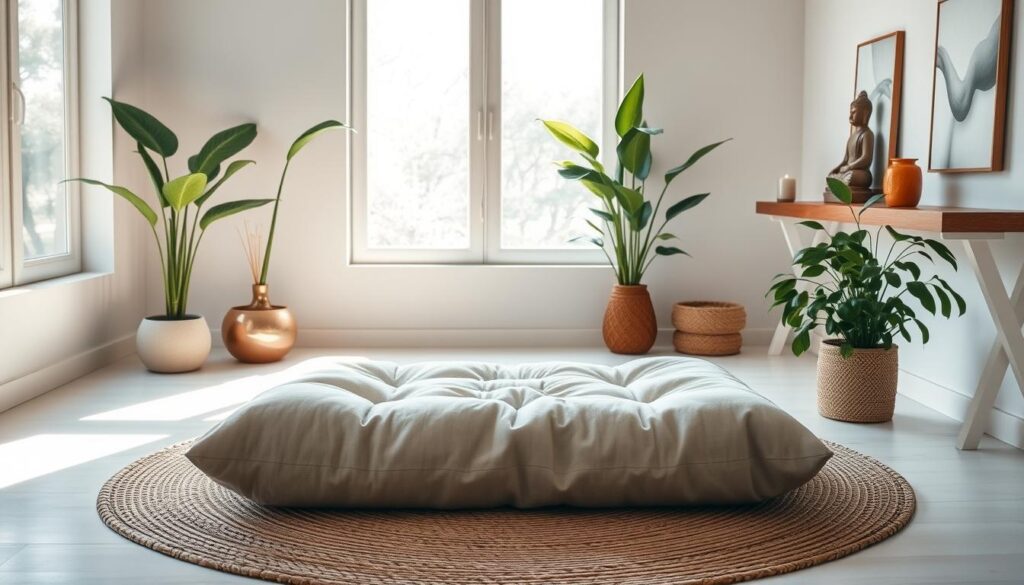
Floor Cushions and Breathable Fabrics
Traditional pillows like zabuton (flat Japanese cushions) support posture better than bulky Western options. Pair them with linen or cotton covers for breathability. For small spaces, try foldable options or repurpose a closet.
- Zabuton vs. Western: Firmer filling aligns the spine; plusher styles suit short sessions.
- Balcony Conversions: Add a weatherproof mat and sheer curtains for privacy.
Personalized Spiritual Touches
Sacred geometry artwork, like mandalas, fosters focus. Etsy artisans and Society6 offer affordable prints. A Japanese-inspired platform with a kneeling bench (shown above) merges tradition with modern zen room aesthetics.
“A singing bowl’s vibrations center the mind faster than white noise machines,” notes a Kyoto design study.
Accessibility Tip: Use armchairs with lumbar support for mobility-limited users. The goal is serenity, not strain.
6. Bring Nature Indoors with Greenery
NASA research proves greenery isn’t just decorative—it’s essential for healthy living spaces. Their Clean Air Study shows peace lilies remove 60% of airborne toxins, while snake plants filter nighttime air. These natural elements boost oxygen levels and reduce stress hormones.
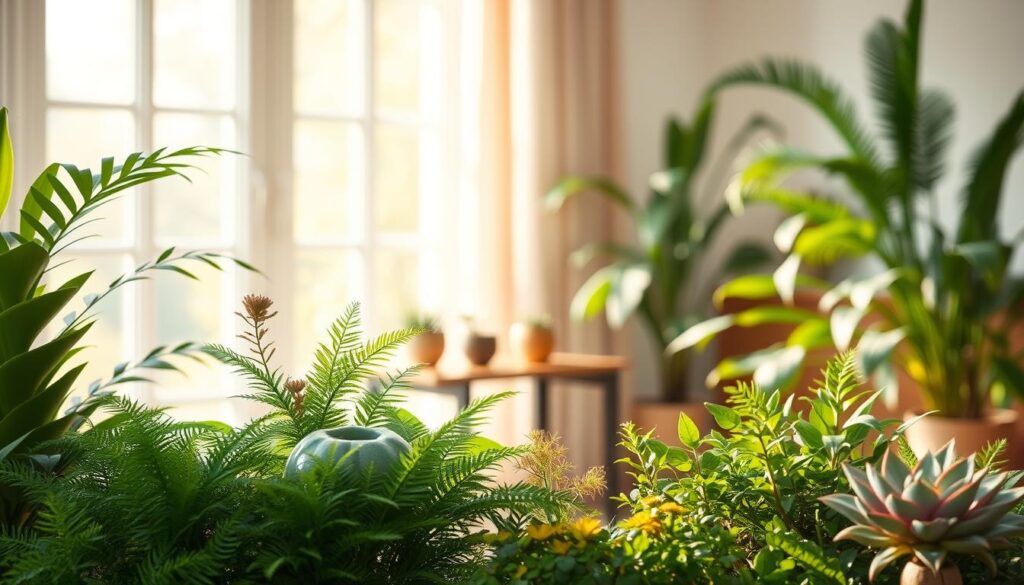
Air-Purifying Plant Guide
Choose plants based on your care commitment:
- Beginner: Snake plant (survives low light, weekly watering)
- Intermediate: Spider plant (pet-safe, purifies formaldehyde)
- Expert: Maidenhair fern (needs humidity, distilled water)
Peace lilies outperform standard air purifiers by neutralizing ammonia and benzene compounds.
Miniature Zen Gardens
Create a tabletop retreat with:
- Aqua gravel or fine sand for raking patterns
- Miniature bamboo rakes for mindful arranging
- Small river stones as focal points
For pet owners, ASPCA-approved options include:
- Boston ferns (non-toxic, lush foliage)
- Parlor palms (safe for cats/dogs)
A Bangalore home transformed their balcony with vertical felt planters—proof that any space can embrace nature. Smart sensors like Parrot Flower Power simplify care with moisture alerts.
7. Opt for Light, Natural Textiles
Lightweight fabrics transform rooms into breezy retreats with effortless style. Linen sales surged 33% this summer as homeowners seek comfort and sustainability. These textiles regulate temperature while adding organic texture to your palette.

Cotton, Linen, and Silk Drapes
Choose window treatments based on light needs and care preferences:
- 230GSM linen: Ideal for filtered sunlight; develops soft wrinkles
- 300TC cotton: Denser weave blocks 60% of UV rays
- Charmeuse silk: Luxe sheen; requires blackout lining
Layer sheer panels under heavier drapes for flexibility. Brands like Coyuchi use organic dyes that won’t fade.
Penang’s bamboo blind system reduced cooling costs by 18% while maintaining privacy.
Neutral-Toned Rugs for Texture
Ground your floor with natural fiber rugs in these sizes:
- 8×10 ft anchors living rooms
- 5×7 ft fits under bed frames
Jute and sisal add earthy tones without overwhelming spaces. For high-traffic areas, Boll & Branch’s wool blends withstand daily use.
Pro tip: Rotate rugs seasonally to prevent sun damage. Store silk drapes in muslin bags during summer months.
8. Maximize Natural Light
Architects agree: natural light is the foundation of peaceful interiors. First Source reports 92% prioritize daylighting in designs that promote calm. The right balance of sunlight reduces eye strain and enhances the look of any room.
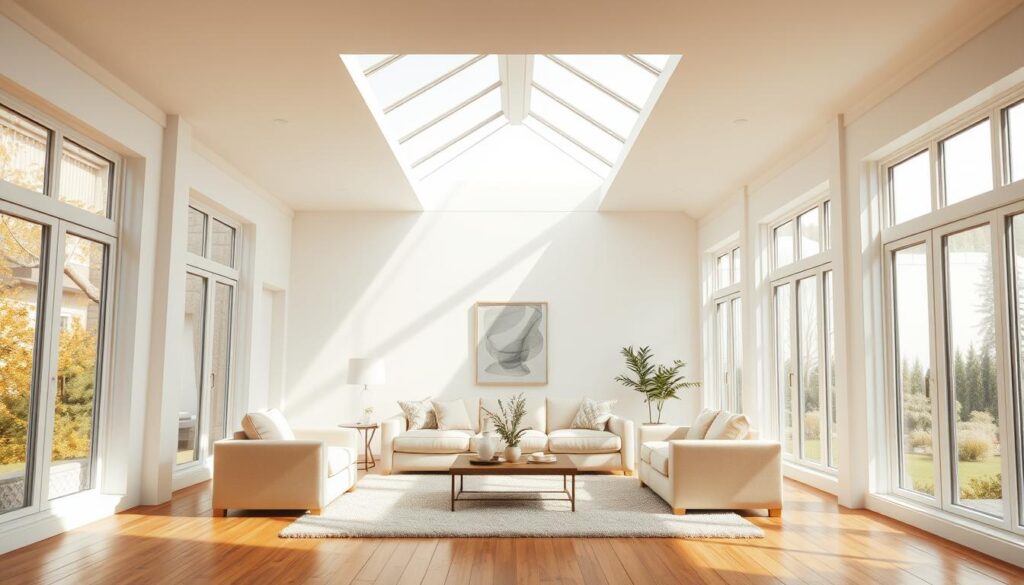
Window Treatments That Welcome Light
Sheer curtains diffuse sunlight while maintaining privacy. Compare Roman shades (excellent light control) to roller shades (sleeker profiles). For south-facing windows, UV-filtering films like 3M’s Prestige block heat without darkening spaces.
A Mumbai high-rise used prismatic window film to reduce glare by 78%. Homeowners concerned about privacy can opt for frosted glass or top-down-bottom-up shades.
Strategic Mirror Placement
Position mirrors opposite windows to double sunlight. Hallway mirrors bounce light into darker areas. For floors, polished concrete or metallic accents amplify brightness naturally.
“Daylight-centric designs show 22% higher occupant satisfaction,” notes the American Institute of Architects.
Keep windows unobstructed during peak daylight hours. Even small changes—like trimming outdoor foliage—can dramatically increase incoming light.
9. Add Japanese-Inspired Elements
Japanese design principles offer more than beauty—they create spaces that breathe. Tatami mat imports rose 27% since 2023, showing growing Western appreciation for these timeless elements. From sliding screens to living art, each piece serves both form and function.
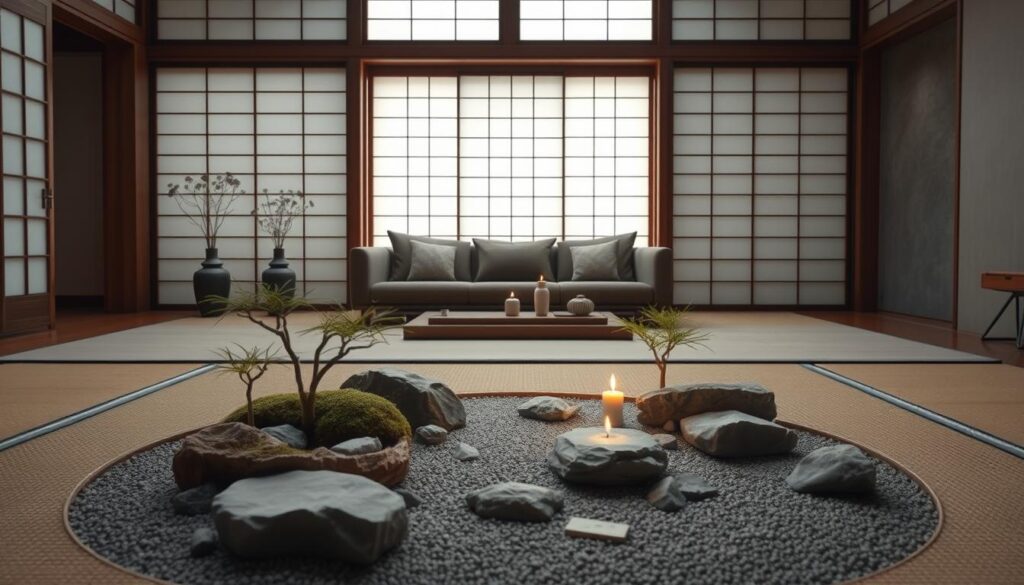
Shoji Screens or Tatami Mats
Traditional wood-framed shoji screens use washi paper for soft light diffusion. Modern acrylic versions offer durability but lack the authentic texture. For homes with pets or kids, hybrid dividers combine rice paper upper panels with wipeable lower sections.
Tatami mats require simple care:
- Rotate quarterly to evenly distribute wear
- Maintain 40-60% humidity to prevent cracking
- Vacuum with brush attachment weekly
“Our Kyoto-inspired tea corner uses half-tatami platforms—Western comfort meets Japanese tradition,” notes Totoro Rug Company’s lead designer.
Kokedama (Moss Ball) Planters
These living sculptures wrap roots in sphagnum moss instead of pots. Start with small ferns or pilea plants:
- Soak moss until pliable
- Wrap root ball tightly with twine
- Mist every 3 days in bright, indirect light
Japan Objects Store sells pre-made kokedama for beginners. For interior displays, hang them at varying heights with macramé hangers.
Even small additions—like a woven tansu chest or matcha set—bring inspiration from Japan’s zen design heritage. The key is choosing pieces that resonate with your daily rhythm.
10. Smart Storage for Clutter-Free Zen
Hidden storage solutions are revolutionizing modern homes by blending function with minimalist design. IKEA reports a 19% sales jump for their PS 2014 cabinets, proving demand for concealed storage is rising. These innovations help maintain calm spaces without sacrificing accessibility.

Space-Saving Furniture Systems
Modular designs like Elfa’s customizable shelves adapt to any room. Compare top systems:
| Feature | Elfa (The Container Store) | Custom Closet |
|---|---|---|
| Price per sq. ft. | $12-$25 | $18-$32 |
| Weight Capacity | 100 lbs/shelf | 150 lbs/shelf |
| Child-Friendly | Optional safety locks | Built-in rounded edges |
Under-stair nooks can transform into reading corners with built-in drawers. For beds, consider platforms with hydraulic lift storage—ideal for seasonal items.
Natural Fiber Organizers
Woven baskets add texture while reducing clutter. Seagrass lasts 5+ years indoors, while water hyacinth resists moisture in bathrooms. Labeled bins help kids maintain tidy spaces.
“Our Johor Bahru kitchen hides appliances behind sliding rattan panels—guests only see the calm,” says Third Source’s lead designer.
Hollow ottomans store blankets yet serve as seating. For small homes, wall-mounted shelves with linen curtains keep essentials handy but unseen. The right storage turns chaos into order.
Conclusion: Crafting Your Zen House Aesthetic
Transforming your home into a peaceful retreat doesn’t require a complete overhaul. Start small—a meditation nook or earthy color palette can set the tone. Studies show 84% of homeowners feel happier after embracing these calming changes.
Remember the core principles: simplicity, natural elements, and intentional design. A Dallas loft took six months to fully transition, proving gradual updates work best. Personal touches, like a handmade vase or favorite plant, add meaning without clutter.
Download our free design checklist to begin your journey. Whether it’s soft lighting or smart storage, each step brings you closer to a space that inspires peace and relaxation.

